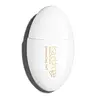What's inside
What's inside
 Key Ingredients
Key Ingredients

 Benefits
Benefits

 Concerns
Concerns

 Ingredients Side-by-side
Ingredients Side-by-side

Water
Skin ConditioningCoconut Alkanes
EmollientIsodecyl Neopentanoate
EmollientGlycerin
HumectantDimethicone
EmollientPEG-30 Dipolyhydroxystearate
EmulsifyingC12-15 Alkyl Benzoate
AntimicrobialSilica
AbrasiveCoco-Caprylate/Caprate
EmollientPolyglyceryl-4 Isostearate
EmulsifyingCorn Starch Modified
AbsorbentOpuntia Ficus-Indica Seed Oil
EmollientHelianthus Annuus Seed Oil
EmollientHydrogenated Castor Oil
EmollientTocopherol
AntioxidantPropylene Carbonate
SolventSqualane
EmollientDimethicone/Vinyl Dimethicone Crosspolymer
Skin ConditioningSalicylic Acid
MaskingSodium Chloride
MaskingSodium Hydroxide
BufferingGlyceryl Caprylate
EmollientSodium Benzoate
MaskingPhenoxyethanol
PreservativeStearalkonium Hectorite
Gel FormingIron Oxides
CI 77492
Cosmetic ColorantCI 77499
Cosmetic ColorantCI 77491
Cosmetic ColorantWater, Coconut Alkanes, Isodecyl Neopentanoate, Glycerin, Dimethicone, PEG-30 Dipolyhydroxystearate, C12-15 Alkyl Benzoate, Silica, Coco-Caprylate/Caprate, Polyglyceryl-4 Isostearate, Corn Starch Modified, Opuntia Ficus-Indica Seed Oil, Helianthus Annuus Seed Oil, Hydrogenated Castor Oil, Tocopherol, Propylene Carbonate, Squalane, Dimethicone/Vinyl Dimethicone Crosspolymer, Salicylic Acid, Sodium Chloride, Sodium Hydroxide, Glyceryl Caprylate, Sodium Benzoate, Phenoxyethanol, Stearalkonium Hectorite, Iron Oxides, CI 77492, CI 77499, CI 77491
Zinc Oxide 12.6%
Cosmetic ColorantWater
Skin ConditioningIsononyl Isononanoate
EmollientC9-12 Alkane
SolventButyloctyl Salicylate
Skin ConditioningPolyglyceryl-6 Polyricinoleate
EmulsifyingCaprylic/Capric Triglyceride
MaskingGlycerin
HumectantEthylhexyl Methoxycrylene
Skin ConditioningTrimethylsiloxysilicate
EmollientMica
Cosmetic ColorantPolyglyceryl-2 Isostearate
EmulsifyingSodium Chloride
MaskingPhenoxyethanol
PreservativeDisteardimonium Hectorite
StabilisingPolyglyceryl-3 Polyricinoleate
EmulsifyingPolyhydroxystearic Acid
EmulsifyingCoco-Caprylate/Caprate
EmollientIsostearic Acid
CleansingLecithin
EmollientPolyglyceryl-6 Polyhydroxystearate
EmulsifyingJojoba Esters
EmollientEthylhexylglycerin
Skin ConditioningSodium Phytate
Aloe Barbadensis Leaf Water
MaskingCentella Asiatica Extract
CleansingOpuntia Tuna Fruit
Skin ConditioningSalvia Officinalis Extract
AntimicrobialIron Oxides
CI 77891
Cosmetic ColorantZinc Oxide 12.6%, Water, Isononyl Isononanoate, C9-12 Alkane, Butyloctyl Salicylate, Polyglyceryl-6 Polyricinoleate, Caprylic/Capric Triglyceride, Glycerin, Ethylhexyl Methoxycrylene, Trimethylsiloxysilicate, Mica, Polyglyceryl-2 Isostearate, Sodium Chloride, Phenoxyethanol, Disteardimonium Hectorite, Polyglyceryl-3 Polyricinoleate, Polyhydroxystearic Acid, Coco-Caprylate/Caprate, Isostearic Acid, Lecithin, Polyglyceryl-6 Polyhydroxystearate, Jojoba Esters, Ethylhexylglycerin, Sodium Phytate, Aloe Barbadensis Leaf Water, Centella Asiatica Extract, Opuntia Tuna Fruit, Salvia Officinalis Extract, Iron Oxides, CI 77891
 Reviews
Reviews

Ingredients Explained
These ingredients are found in both products.
Ingredients higher up in an ingredient list are typically present in a larger amount.
Coco-Caprylate/Caprate is created from fatty coconut alcohol, caprylic acid, and capric acid.
It is a lightweight emollient. Emollients create a thin barrier on the skin to trap moisture in. This helps keep your skin hydrated and soft.
Once applied, Coco-Caprylate/Caprate is absorbed quickly and leaves a silky feel.
Coco-Caprylate/Caprate may not be fungal acne safe.
Learn more about Coco-Caprylate/CaprateGlycerin is already naturally found in your skin. It helps moisturize and protect your skin.
A study from 2016 found glycerin to be more effective as a humectant than AHAs and hyaluronic acid.
As a humectant, it helps the skin stay hydrated by pulling moisture to your skin. The low molecular weight of glycerin allows it to pull moisture into the deeper layers of your skin.
Hydrated skin improves your skin barrier; Your skin barrier helps protect against irritants and bacteria.
Glycerin has also been found to have antimicrobial and antiviral properties. Due to these properties, glycerin is often used in wound and burn treatments.
In cosmetics, glycerin is usually derived from plants such as soybean or palm. However, it can also be sourced from animals, such as tallow or animal fat.
This ingredient is organic, colorless, odorless, and non-toxic.
Glycerin is the name for this ingredient in American English. British English uses Glycerol/Glycerine.
Learn more about GlycerinPhenoxyethanol is a preservative that has germicide, antimicrobial, and aromatic properties. Studies show that phenoxyethanol can prevent microbial growth. By itself, it has a scent that is similar to that of a rose.
It's often used in formulations along with Caprylyl Glycol to preserve the shelf life of products.
Chances are, you eat sodium chloride every day. Sodium Chloride is also known as table salt.
This ingredient has many purposes in skincare: thickener, emulsifier, and exfoliator.
You'll most likely find this ingredient in cleansers where it is used to create a gel-like texture. As an emulsifier, it also prevents ingredients from separating.
There is much debate on whether this ingredient is comedogenic. The short answer - comedogenic ratings don't tell the whole story. Learn more about comegodenic ratings here.
The concensus about this ingredient causing acne seems to be divided. Research is needed to understand if this ingredient does cause acne.
Scrubs may use salt as the primary exfoliating ingredient.
Learn more about Sodium ChlorideWater. It's the most common cosmetic ingredient of all. You'll usually see it at the top of ingredient lists, meaning that it makes up the largest part of the product.
So why is it so popular? Water most often acts as a solvent - this means that it helps dissolve other ingredients into the formulation.
You'll also recognize water as that liquid we all need to stay alive. If you see this, drink a glass of water. Stay hydrated!
Learn more about WaterThis ingredient is a combination of red, black, and yellow iron oxide pigments. This combination of colors is usually found in foundation, because it results in a "skin" color.